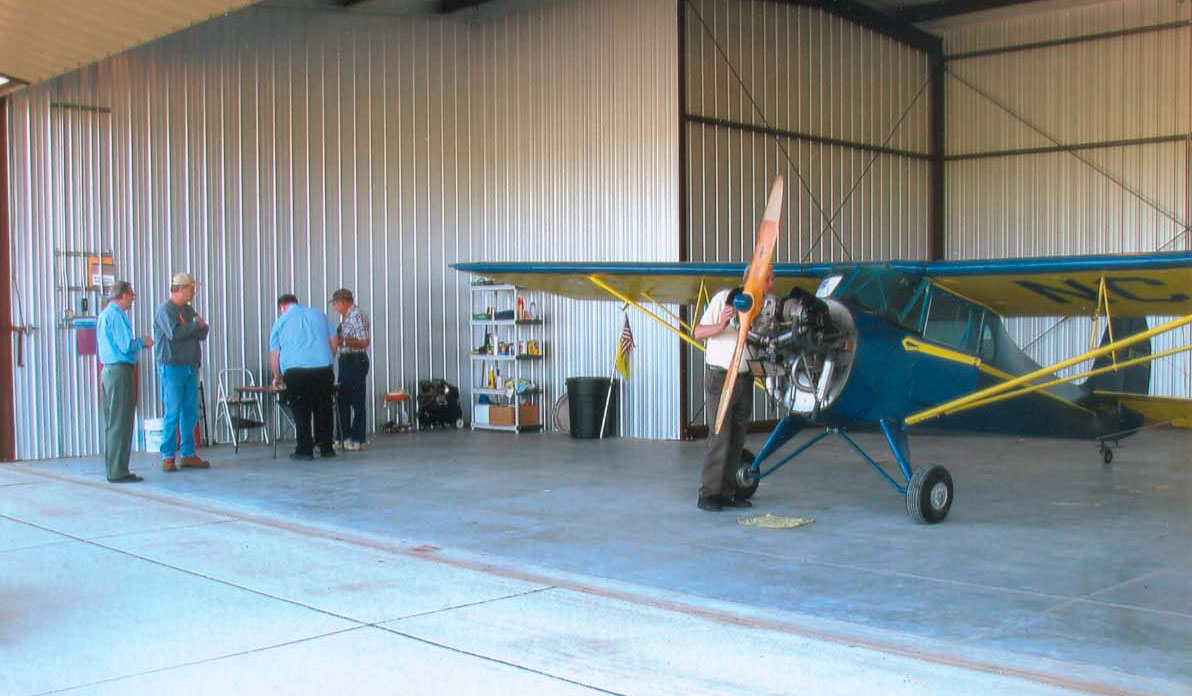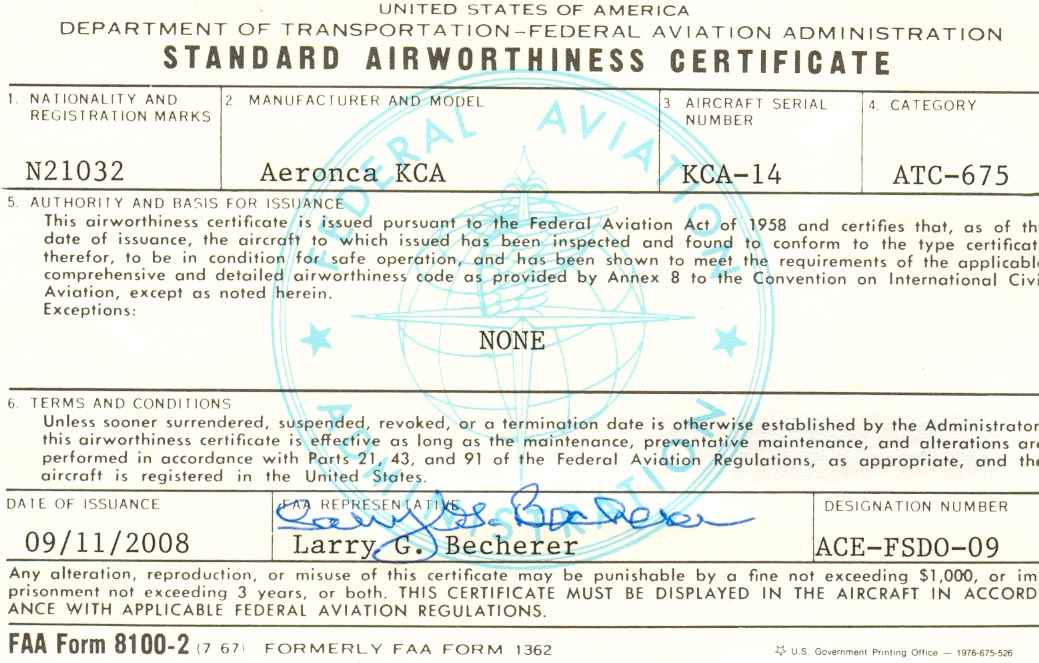A chapter must be written regarding paperwork issues in restoring KCA-14. The original concept was based on having finished a homebuilt Aircamper, and thinking how nice it would be to do a rebuild on a "65 hp" lightplane where all the bits and pieces are already in one place, the rigging has been accomplished with all the struts the right length etc. That concept was sound, and the technology and construction skills translated very well over to the Aeronca.
What did not translate well was an awareness of the regulatory climate which applied to the Aircamper versus that which came into play on the Aeronca. The most critical was the issue of the Certificate of Airworthiness. That document was obtained with so little fanfare on the Aircamper that it was effectively forgotten. Now that little piece of paper duly displayed in its plastic sleeve in the cockpit means much more to me.
A bit of history, as I understand it, should be noted. All certified aircraft are issued a Certificate of Airworthiness (C of A) when built. Before the mid-fifties, the inspecting mechanic would re-issue a new C of A whenever the plane was annualed. After the mid-fifties the process changed to a "non-renewing C of A" sometimes called a "permanent C of A" and the annual was noted only in the logbooks.
Separate from this document is the aircraft registration of ownership, which the owner obtains from the FAA and involves a biennial report of any updates to address etc. and is keyed to the "N" number of the plane. Since these two documents are FAA requirements one might think that they are somehow coordinated. Not so.
Fortunately I can report a third party account which illustrates this issue without having to identify any specific parties involved in my own situation. Through the wonderful resource of online airplane forums, in this case the Taylorcraft Foundation forum as I recall, I learned of the story of a man from Sandwich, Illinois. (The phrase "where in heck is Sandwich" will be familiar to Trade-a-plane readers) This helpful gent, with whom I was able to speak by phone, had restored a J-3 Cub which was missing its C of A document.
I can't help but insert here that thirty-some years ago Sandwich was the destination point of one of my first solo cross-country flights as a student in an Aeronca Champ. I DO know where the heck Sandwich is.
This J-3 needed a new C of A, and since it was duly registered and had its N number, the owner set out to get a replacement copy from the FAA. He was to find out that this was not such a simple process for the reasons we are about to explain.
IF the J-3 in question had been issued a non-renewing C of A back in the fifties (as most were) then the FAA record archives would have a copy of it and it would be routine to receive a replacement copy for a "lost" document. What the man from Sandwich discovered, and what I was to discover, and what the reader should be alerted to, is that some old airplanes NEVER received a non-renewing C of A back in the fifties! In fact, more than one FAA inspector has told me they encounter this situation "all the time." How could THAT happen?
To continue with the J-3 example, the man from Sandwich took all of his aircraft records to the Illinois FAA office to plead his case that he had a "real" airplane which once obviously had a C of A and why could he not get a replacement document now? His theory was that over the years, with transfers of records from paper to microfilm to digital...something was lost; that it was a "mistake."
At that point the FAA man in the Illinois office chose a poor time to make what may have been intended as a humorous comment. He said, "we don't make mistakes." At this point, the man from Sandwich folded his cards and left in disgust. And he still tells the story with bitterness decades later. The J-3 issue was resolved when the airplane was moved to Wisconsin and processed through another office in the following way:
At the time in the fifties when the transition from annual renewal of the C of A to the non-renewing document, owners were given a grace period of a year to accomplish the simple exchange of documents with the FAA. After the grace period expired, those who had failed to do so could still receive their non-renewing document by passing a "conformity inspection" conducted by an FAA inspector.
Now many years later, this is still the prescribed fix for this situation. Somehow the Wisconsin office was able to give assurance to the J-3 owner that this inspection was not intended to obstruct or prevent his project from being completed. It was painless and the document was issued.
It should be explained that a "conformity inspection" exists primarily for manufacturers. When a plane rolls off the assembly line, this is a document which is signed off by an authorized inspector to affirm that the airplane was built according to the specifications of its type certificate. It is obvious that this resolves an issue between FAA and manufacturer, and would not lend itself to subsequent issues between FAA and an aircraft owner. But under the circumstances of the change in C of A issuance in the fifties, it was pressed into service to do this.

Conformity inspection in "another state"
Now some more about "how could that happen?" Let's call it the "not my problem" syndrome. Since big targets go first, what about the FAA. We all know about cars and how they are titled and licensed. If you want to license your car, you have to give evidence of title. If you want to sell your car, you transfer title. Forget all that when dealing with airplanes. Airplanes do not have titles.
You can buy an airplane with an FAA bill of sale, register that airplane with the FAA and receive an N number, spend years restoring that airplane to the letter of FAA regulations, and find that the FAA will not allow that airplane to fly if it does not have a Certificate of Airworthiness on board. Since FAA has records of all of the above, wouldn't it make sense to alert any buyer, or applicant for registration, that the airplane in question didn't have a Certificate of Airworthiness? The owner, says FAA in effect, is responsible for this matter and it is "not our problem."
The next culprit in the "how could that happen" story is the "annual inspection" system. The FAA authorizes private individuals who meet their standards to inspect any airplane and issue a certification in the logbook that the airplane is in airworthy condition. (as noted, this used to include typing up a new C of A each year) These mechanics are the people in the field who we all rely on to either do or supervise any work that is done to our planes. While they work under FAA authority, they typically view the FAA as a sometimes "difficult partner" to put it mildly.
Let us speculate that our friend with the J-3 got his restoration done, kept his registration and N number up to date, and his mechanic might have said with a wink as he signed off the annual inspection, "it's ready to go, don't forget to have the required documents on board when you fly it." No C of A? It's "not his problem." We speculate that this must happen, or it would not be possible for pre-fifties airplanes to be found without non-renewing C of A's "all the time." (FAA quote) We were fortunate to have mechanics who were both scrupulous and helpful in getting the problem resolved with our Aeronca.
Or possibly the J-3 owner had other airplanes with the non-renewing C of A tucked away in the plastic sleeve, and just assumed the one he had in the Cub was one of those (though it would have been a pre-1956 document). Add to this the fact that originally the forms looked identical. Add to this the simple fact that if the owner doesn't tell anyone that he doesn't have a non-renewing C of A, or tells his mechanic that he "has it at home" or somewhere else, this is going to slip through. The writer, fortunately or unfortunately, is naive enough to tell everyone everything.
1. Owners, 2. mechanics, and 3. FAA people who say "it's not my problem" are the answer to the question "how could that happen?"

Now, these wheels look "right"
We were fortunate to find an FAA inspector who had "the right stuff." He remembered our KCA from its Nebraska days, and one particular observation he made struck a chord. "Are those the right wheels?" Well, no, they don't look right and we had been looking for a set of Shinn wheels to replace the Clevelands shown on our airplane from its California days. We already had them cleaned up, and installed them for the conformity inspection. Though the inspector was not about to make an issue of this, it was nice to be "on the same page" for a change. Clevelands of that style were seen frequently on L-3 Aeroncas. They do not appear on the approved equipment list for the KCA, but there was no paperwork showing the substitution. A bit of a mystery surfaced when the Shinn model number on our new wheels was also absent from the approved list. Apparently our Shinns were from a later Chief which did not have a tapered axle as did the earlier ones. But, no issue was taken at this discrepancy.
After three years of finagling, KCA-14 has "that piece of paper" which it lacked for over fifty years. It's "legal".
